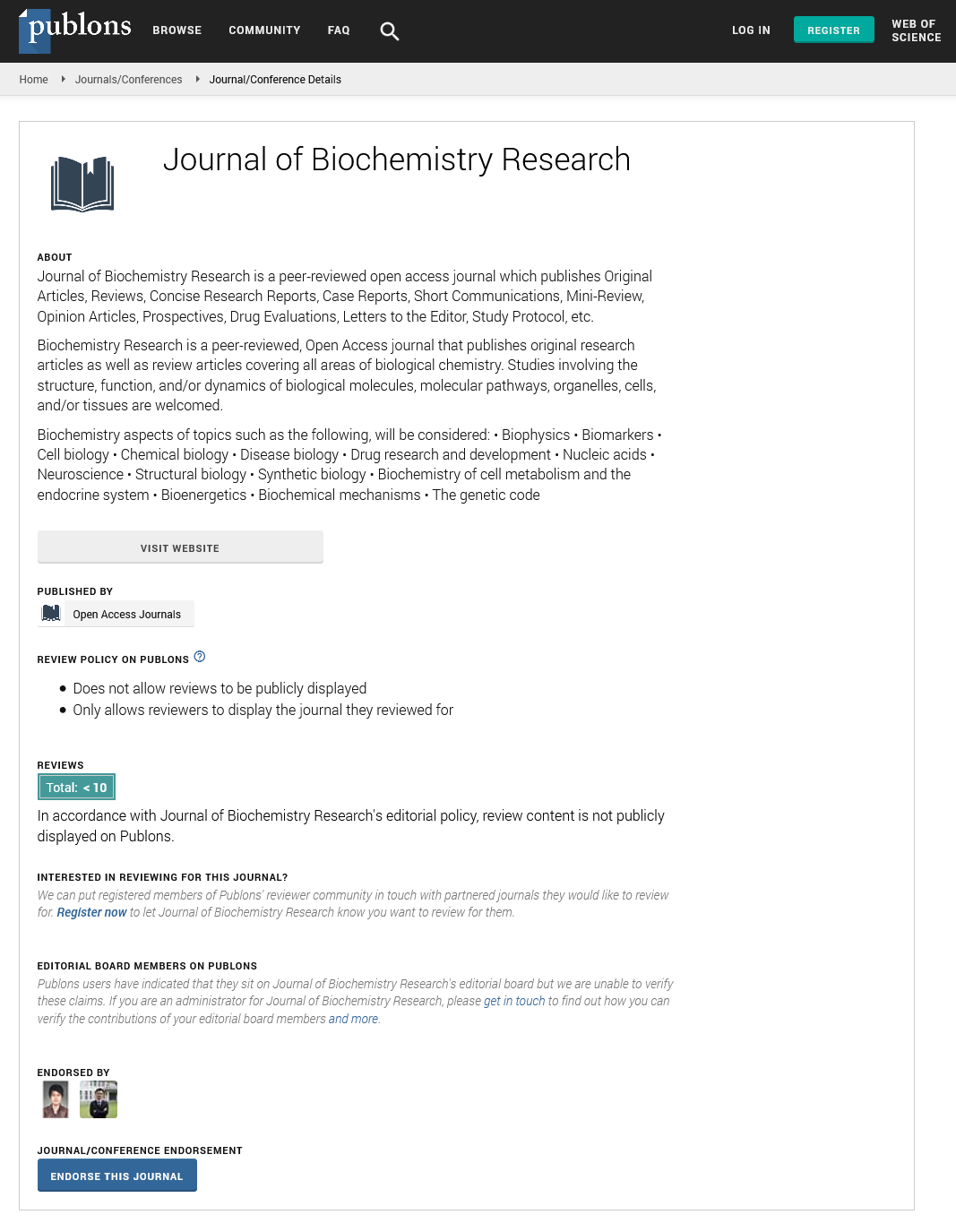Editorial - Journal of Biochemistry Research (2023) Volume 6, Issue 4
Unraveling the Complexity of Biological Molecules: Insights into Structure, Function, and Evolution
Babika Rajput*
Department of Biochemistry, University of Delhi, India
Department of Biochemistry, University of Delhi, India
E-mail: BabikaRajput43@gmail.com
Received: 1-August-2023, Manuscript No.oabr-23-109721; Editor assigned: 4- August-2023, Pre-QC No.oabr-23-109721 (PQ); Reviewed: 14-August-2023, QC No.oabr-23-109721; Revised: 22-August-2023, Manuscript No.oabr-23-109721 (R); Published: 31-August-2023 DOI: 10.37532/ oabr.2023.6(4).107-110
Abstract
Biological molecules constitute the fundamental building blocks of life, orchestrating the intricate processes that sustain living organisms. Understanding the complexity of these molecules, their diverse structures, a multifaceted function, and evolutionary origins, represents a captivating and indispensable pursuit in modern life sciences. This article delves into the multidimensional world of biological molecules, unraveling the intricacies of their molecular structures and the underlying principles governing their functions. The interplay of molecular biology, biochemistry, and structural biology offers valuable insights into the dynamic interactions and signaling networks orchestrated by these molecules, shaping the physiology and behavior of living systems. The discussion encompasses an array of biological molecules, including proteins, nucleic acids, lipids, and carbohydrates, showcasing the diversity of functions they perform within cells and organisms. Investigating the molecular mechanisms that underpin enzymatic catalysis, gene regulation, and cellular signaling provides a comprehensive understanding of how biological molecules orchestrate life’s complexity. Furthermore, an exploration of the evolutionary history of biological molecules sheds light on their origins and adaptive trajectories throughout geological epochs. By employing comparative genomics and phylogenetic analyses, we discern shared ancestral relationships among these molecules and gain insights into the selective pressures that have driven their functional diversification over evolutionary time. The article also highlights the relevance of understanding biological molecules in the context of human health and disease. Examining how genetic mutations, structural alterations, and dysregulation of molecular interactions contribute to the development of diseases illuminates new therapeutic avenues and precision medicine strategies. In conclusion, the exploration of biological molecules offers a gateway to understanding the foundational principles that govern life. From their diverse structures to their multifaceted functions and intricate evolutionary histories, these molecules provide a rich tapestry of insights into the complexity of living systems. This knowledge fosters advancements in biotechnology, drug discovery, and personalized medicine, holding the potential to transform our understanding and management of human health and the natural world. As we unravel the enigmas of biological molecules, we come one step closer to unlocking the secrets of life itself.
Keywords
Biological molecules • Complexity • Molecular structures • Function • Evolution
Introduction
Biological molecules form the intricate foundation upon which life’s complexity and diversity are built. These molecular entities, ranging from proteins and nucleic acids to lipids and carbohydrates, orchestrate the myriad of processes that sustain living organisms. Understanding the multifaceted nature of biological molecules, their intricate structures, diverse functions, and evolutionary origins, is an endeavor that lies at the heart of modern life sciences [1]. In this exploration, we embark on a captivating journey to unravel the complexity of biological molecules and gain insights into their profound role in shaping the biology of living systems [2]. The study of these molecules encompasses a diverse array of disciplines, including molecular biology, biochemistry, and structural biology, each offering unique perspectives on the interplay between molecular structures and functions [3]. The first dimension of this investigation delves into the molecular structures of biological molecules [4]. With their intricate three-dimensional architectures, these molecules serve as the cornerstone of cellular machinery, enabling them to perform an astonishing array of tasks [5]. By elucidating the atomic-level details of these structures, we gain an understanding of the fundamental principles governing their interactions and functions within the cellular environment [6]. The second dimension revolves around the multifaceted functions of biological molecules. From enzymatic catalysis that drives essential chemical reactions to gene regulation that governs the expression of genetic information, these molecules orchestrate the delicate balance required for the proper functioning of living organisms [7]. We delve into the intricacies of cellular signaling networks, where biological molecules act as molecular messengers, transmitting vital information to coordinate diverse cellular activities. The third dimension of this exploration embarks on a voyage through the evolutionary history of biological molecules [8]. By studying the genetic and structural variations among species, we gain valuable insights into the ancient origins of these molecules and the adaptive trajectories they have followed throughout geological epochs [9]. Comparative genomics and phylogenetic analyses unravel shared ancestral relationships among these molecules, offering a deeper appreciation for their ancient lineage and the selective pressures that have driven their functional diversification over evolutionary time. Moreover, the relevance of understanding biological molecules extends beyond the realm of basic science [10]. The insights gained from this investigation have direct implications for human health and disease. We explore how genetic mutations, structural alterations, and dysregulation of molecular interactions contribute to the development of diseases, paving the way for the discovery of novel therapeutic avenues and the advancement of precision medicine strategies. In conclusion, the study of biological molecules represents a fascinating journey into the foundational principles that govern life. The interplay between molecular structures, functions, and evolutionary histories provides a rich tapestry of insights into the complexity of living systems. This knowledge not only deepens our understanding of life’s intricacies but also holds the potential to revolutionize biotechnology, drug discovery, and personalized medicine, elevating our capacity to comprehend and harness the wonders of biological molecules for the betterment of humanity and the natural world. As we embark on this quest to unravel the enigmas of biological molecules, we venture closer to unlocking the secrets of life itself.
Discussion
The discussion on unraveling the complexity of biological molecules and gaining insights into their structure, function, and evolution is a captivating and multifaceted exploration that touches upon several crucial aspects of life sciences and their practical applications. Some key points for discussion include: Molecular Structures and Functions: The discussion can delve into specific examples of complex biological molecules, such as proteins with intricate folding patterns or nucleic acids with diverse secondary structures. Participants can explore how these unique molecular architectures enable specific functions, from enzymatic catalysis to information storage and transfer in cells. Interplay of Molecular Biology and Structural Biology: The integration of molecular biology and structural biology is essential for understanding how biological molecules carry out their functions. Participants can discuss how techniques like X-ray crystallography, NMR spectroscopy, and cryo-electron microscopy have revolutionized our ability to visualize and study these molecules at the atomic level. Cellular Signaling and Regulatory Networks: The discussion can focus on how biological molecules participate in complex signaling pathways and regulatory networks to orchestrate various cellular processes. Examples of key signaling molecules and their roles in cellular communication can be explored, along with the implications for cell function and organismal development. Evolutionary Origins and Adaptive Trajectories: Exploring the evolutionary history of biological molecules can shed light on their ancient origins and the selective pressures that have shaped their functions over time. Participants can discuss specific examples of evolutionary adaptations and how these have contributed to the diversity of molecular functions observed in different organisms. Comparative Genomics and Phylogenetic Analyses: The discussion can emphasize the importance of comparative genomics and phylogenetic analyses in deciphering the relationships between biological molecules across species. Participants can explore how these methods have revealed shared ancestry and the conservation of critical molecular functions throughout evolution. Relevance to Biotechnology and Medicine: The practical implications of understanding biological molecules can be highlighted in the context of biotechnology and medicine. Participants can discuss how knowledge of molecular structures and functions has facilitated the development of novel therapies, drug design, and targeted treatments for various diseases. Challenges and Future Directions: The discussion can address current challenges in studying biological molecules, such as the complexities of understanding protein-protein interactions or the limitations of experimental techniques. Participants can propose potential solutions and future research directions to overcome these challenges. Ethical Considerations: Ethical considerations related to the study of biological molecules, such as the use of genetic information or the potential implications of gene editing technologies, can also be discussed. Participants can explore the ethical implications of applying molecular insights in various fields.
Conclusion
In conclusion, the exploration of unraveling the complexity of biological molecules and gaining insights into their structure, function, and evolution has been a captivating and enlightening journey through the fundamental building blocks of life. The study of these molecules, ranging from proteins and nucleic acids to lipids and carbohydrates, has offered a deep appreciation for the intricacies and versatility that underlie life’s diverse and remarkable processes. Through the integration of molecular biology, biochemistry, and structural biology, we have gained profound insights into the interplay between molecular structures and functions. Visualizing and understanding the atomic-level details of these molecules has revealed the key mechanisms that enable them to carry out specific tasks, from catalyzing essential chemical reactions to orchestrating complex cellular signaling networks. The exploration of the evolutionary history of biological molecules has shed light on their ancient origins and the adaptive trajectories they have followed throughout the course of evolution. Comparative genomics and phylogenetic analyses have uncovered shared ancestral relationships among these molecules, demonstrating the conservation of critical functions and the selective pressures that have driven their functional diversification over geological time. The implications of understanding biological molecules extend far beyond the realm of basic science. The knowledge gained from this exploration has direct applications in biotechnology, where it has fueled advancements in drug discovery, biocatalysis, and personalized medicine. Moreover, insights into the dysregulation of these molecules have paved the way for novel therapeutic interventions and precision medicine strategies to address human health and disease. As we conclude this journey, we are reminded of the profound interconnectedness between the structures, functions, and evolutionary histories of biological molecules and the intricate web of life they support. The study of these molecules continues to inspire future research and innovations, driving us closer to unlocking the secrets of life’s complexity and harnessing this knowledge to tackle some of society’s most pressing challenges. Moving forward, interdisciplinary collaborations and technological advancements will be pivotal in further unraveling the enigmas of biological molecules. Addressing the current challenges and ethical considerations in this field will empower us to make responsible and sustainable strides towards a deeper understanding of life’s building blocks and their implications for the betterment of humanity and the world we inhabit. As we continue to uncover the mysteries of biological molecules, we embrace the limitless possibilities that lie ahead and the transformative impact they hold on the future of science, medicine, and our quest to comprehend the intricate tapestry of life.
References
- Warren KA, Bahrani H, Fox JE et al. NSAIDs in combination therapy for the treatment of chronic pseudophakic cystoid macular edema. Retina. 30, 260-266 (2010).
- Schoenberger SD, Miller DM, Petersen MR et al. Nepafenac for epiretinal membrane surgery. Ophthalmol. 118,1482-1482 (2011).
- Friedman DS, O’Colmain BJ, Munoz B et al. Prevalence of age-related macular degeneration in the United States. Arch Ophthalmol. 122: 564-572 (2004).
- Maloney SC, Fernandes BF, Castiglione E et al. Expression of cyclooxygenase-2 in choroidal neovascular membranes from age-related macular degeneration patients. Retina. 29, 176-180 (2009).
- Hu W, Criswell MH, Ottlecz A et al. Oral administration of lumiracoxib reduces choroidal neovascular membrane development in the rat laser-trauma model. Retina. 25,1054-1064 (2005).
- Chen E, Benz MS, Fish MH et al. Use of nepafenac (Nevanac) in combination with intravitreal anti-VEGF agents in the treatment of recalcitrant exudative macular degeneration requiring monthly injections. Clin Ophthalmol. 4, 1249-1252 (2010).
- Gomi F, Sawa M, Tsujikawa M et al. Topical bromfenac as an adjunctive treatment with intravitreal ranibizumab for exudative age-related macular degeneration. Retina. 32, 1804-1810 (2012).
- Zhou J, Wang S, Xia X et al. Role of intravitreal inflammatory cytokines and angiogenic factors in proliferative diabetic retinopathy. Curr Eye Res. 37, 416-420 (2012).
- Harris R, Beebe-Donk J, Namboodiri KK et al. Inverse association of non-steroidal anti-inflammatory drugs and malignant melanoma among women. Oncol Rep. 8, 655-657 (2001).
- Asgari MM, Maruti SS, White E et al. A large cohort study of Nonsteroidal anti-inflammatory drug use and melanoma incidence. J Natl Cancer Inst. 100, 967-971 (2008).
Google Scholar, Crossref, Indexed at
Google Scholar, Crossref, Indexed at
Google Scholar, Crossref, Indexed at
Google Scholar, Crossref, Indexed at
Google Scholar, Crossref, Indexed at
Google Scholar, Crossref, Indexed at
Google Scholar, Crossref, Indexed at
Google Scholar, Crossref, Indexed at
Google Scholar, Crossref, Indexed at


